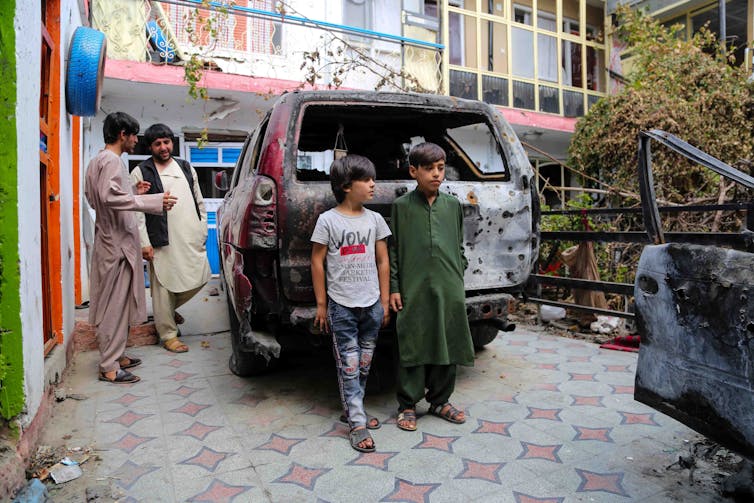Modern guided missiles and bombs are capable of incredible, almost science-fiction-like precision. To research my book, Reaper Force, about the lives of drone operators, I was allowed to watch RAF MQ-9 Reaper drones in real-time action in Syria.
I sat with a three-person crew at a ground-control station in Creech Air Force Base in Nevada as they killed an Islamic State fighter with a Hellfire precision-guided missile. The Reaper drone being piloted was flying 20,000 feet above its target. He was on a moving motorcycle when the missile hit him.
Missile accuracy is judged by how close it gets to its aiming point. Precision refers to the size and predictability of the explosive blast. The strike I watched was accurate and precise and no civilians were hurt.
Degrees of precision
Air-launched missile technology continues to advance rapidly. The 100-pound Hellfire missile was developed to destroy armoured tanks, and its laser targeting is the most accurate system in regular use. It included 20 pounds of explosive charge, though recent versions use less explosives to reduce the risk of collateral damage and civilian deaths.
Having said that, precision can only take you so far: governments do not publish lethal blast-radius information, but a video released by the UK’s Ministry of Defence shows a Hellfire blast radius of several metres. Blast is also affected by the angle at which a missile hits a target, the local topography and any nearby structures which might absorb some of the explosion. Also, even light clouds can disrupt the laser beams that laser-guided missiles like the Hellfire rely on to hit their targets accurately.
This is still much more accurate than more traditional bombs, though these are being improved for accuracy too. Traditional unguided 500-pound, 1,000-pound and 2,000-pound “dumb” bombs are being converted into “smart” Guided Bomb Units (GBU) by attaching a Joint Direct Attack Munition (JDAM) guidance tail kit.
The JDAM contains inertial navigation – an internal computer and gyroscopes to ensure it flies straight – as well as global positioning-system guidance capabilities. They can only hit coordinates and can’t “see” or avoid civilians, though unlike the Hellfire missiles, they are not affected by cloud cover. The 2,000-pound version can be lethal up to several hundred metres away but the guidance kit enables them to strike between [10 and 30 metres] of their targets.
Danger to civilians
The development of more precise missiles and guided bombs does not automatically mean a reduction in civilian deaths. For one thing, “precision” is not about protecting civilians so much as making these weapons “more lethal”.
A whole range of factors affect the civilian risk during a “precision” attack. These include the size and explosive yield of the missile or bomb; the training and experience of the aircrew involved; the quality of the military intelligence; and the operational environment in which the attack is made.
Political implications for the countries involved are also a factor. The British government, for example, has faced public scrutiny for civilian deaths in air strikes in a way that, say, the Russian president, Vladimir Putin, has not.
Much also depends on the rules of engagement – or legal guidance, because they will set out how many civilians a government is prepared, or not, to allow its air force to kill in pursuit of its military campaign objectives.
Law of war
The law of war – which includes the Geneva Conventions – requires civilians to be protected in war and not attacked. But – and this is not commonly understood – the law allows civilians to be legally killed in some circumstances: where the number of deaths is judged by the attacker not to be “excessive in relation to the concrete and [direct military advantage] anticipated”. So if a target is judged to be valuable enough, and the military advantage important enough, civilians can and will be killed.
On August 29 2021, ten Afghan civilians were killed by a Hellfire missile from a US Reaper drone. The precision of the missile did not save them. The crew responsible made the mistake through a combination of human error, miscommunication and the fact that the family’s Toyota Corolla had been wrongly identified as the car of an important ISIS target.

Lieutenant General Sami Said, the US air force inspector general, described it as “an honest mistake”. His enquiry also found that the crew had not broken the law of war.
Sometimes harming civilians is the point
Sometimes air power is also used to directly target or coerce civilian populations. For example, in 2016 Amnesty International reported air attacks by Russian forces on Syrian hospitals. Six hospitals or medical facilities were bombed in three months in areas controlled by forces opposed to the Syrian government. Dozens of civilians were killed or injured. This, despite hospitals being explicitly protected under international humanitarian law.
Direct hits on all of those hospitals indicate the operational effectiveness of the aircraft and weapons involved. Russia was open about its use of “precision” weapons by its air force in Syria at the time. Putin spoke of Russia acting in Syria in support of its government within “the norms of international law”. When he referred to Russian strike aircraft producing “positive results"m, it was about keeping Syria’s government in power, not protecting civilians.
What does the future hold?
As aerial firepower has become more sophisticated, the risks of civilian deaths also rise for other reasons. For example, IS has repeatedly demonstrated effective methods of reducing its enemy’s aerial advantage, such as resorting to urban warfare and creating a network of tunnels under cities such as Mosul and Fallujah in Iraq.
In urban warfare it is impossible to avoid all civilian deaths. A camera in the sky cannot tell if there are civilians out of sight behind walls, in buildings, under trees or in tunnels. Choosing not to shoot is the only sure protection for civilians in unclear circumstances.
For all these reasons, no degree of missile precision will stop the tragedy of civilian deaths in war. And wars show no sign of ending. Perhaps it is time for a more honest dialogue about the limits of technology and the human costs involved.

